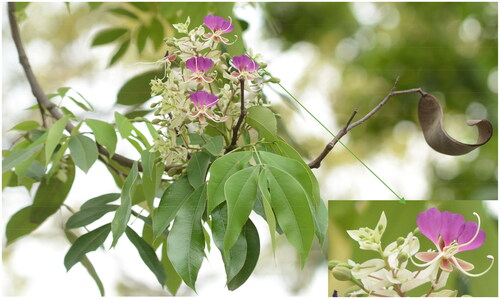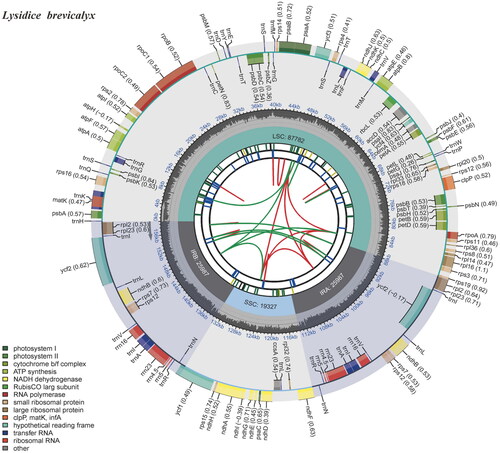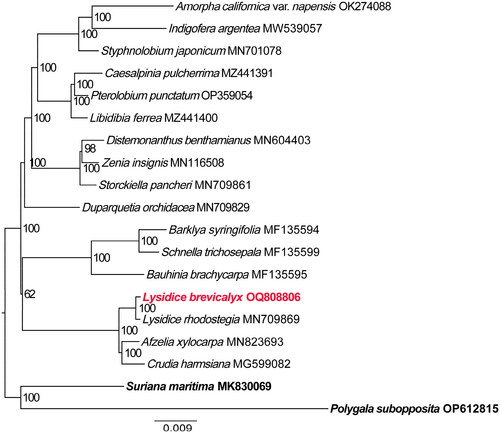Figures & data
Figure 1. Plant image of Lysidice brevicalyx. The image showing flowers are actinomorphic, with purple flag and wing petals, an evenly pinnate leaf, flattened, twisted pods. This photo was taken by youpai zeng.

Figure 2. Gene map of the plastid genome of Lysidice brevicalyx. From the center outward, the first track indicates the dispersed repeats; the second track shows the long tandem repeats as short blue bars; the third track shows the short tandem repeats or microsatellite sequences as short bars with different colors; the fourth track shows small single-copy (SSC), inverted repeat (IRA and IRB), and large single-copy (LSC) regions. The GC content along the genome is plotted on the fifth track; the genes are shown on the sixth track.

Figure 3. The phylogenetic position for Lysidice brevicalyx according to the ML phylogenetic tree constructed based on74 plastid genomes. The following sequences were used: Polygala subopposita OP612815 and suriana maritima MK830069 (Lai et al. Citation2019b) as outgroup, Crudia harmsiana MG599082 (Tosso et al. Citation2018), Afzelia xylocarpa MN823693 (Zhang et al. Citation2020a), Lysidice rhodostegia MN709869 (Zhang et al. Citation2020b), bauhinia brachycarpa MF135595 (Wang et al. Citation2018), schnella trichosepala MF135599 (Wang et al. Citation2018) Barklya syringifolia MF135594 (Wang et al. Citation2018), duparquetia orchidacea MN709829 (Zhang et al. Citation2020b), storckiella pancheri MN709861 (Zhang et al. Citation2020b), zenia insignis MN116508 (Lai et al. Citation2019a) distemonanthus benthamianus MN604403 (Demenou et al. Citation2020), libidibia ferrea MZ441400 (Aecyo et al. Citation2021), pterolobium punctatum OP359054 (Zhang et al. Citation2020b), caesalpinia pulcherrima MZ441391 (Aecyo et al. Citation2021) styphnolobium japonicum MN701078 (Shi and Liu Citation2019), indigofera argentea MW539057 amorpha californica var. napensis OK274088 (Agudelo et al. Citation2022) The sequences used for the tree structure are coding sequences, and the bootstrap support values are shown on the nodes. The scale bar represents the numbers of substitutions per site.

Supplemental Material
Download MS Word (4.9 MB)Data availability statement
The complete plastid genome sequence of L. brevicalyx has been deposited in the NCBI GenBank database under the accession number OQ808806 (these numbers were automatically generated by NCBI and refer to the same sample). The associated BioProject, SRA, and Bio-Sample numbers are PRJNA955444, SRR24167046, and SAMN34178680 respectively.
